Lyric FM Gloria
Listeners to Sunday morning’s Lyric FM Gloria will instantly recognise Tim Thurston. His rich baritone voice and unusual name arrests anybody turning the dial and tuning in.
The popular Sunday morning radio programme, which runs from 8am to 10am, had its beginnings in December 1996. It was a selection of Christmas music broadcast on RTE¨ One’s Crosscurrents.
It proved popular with listeners and Tim continued with more episodes. When Lyric FM opened, the programme was transformed into Gloria and was first broadcast in 1999.
Having sung in a number of choirs throughout the years, and helped organise a number of Early Music Festivals, Tim has a particular knowledge and understanding of sacred music. Today, few parish churches have the resources for elaborate music, and that sadly can also be said for most cathedrals and abbeys. Thus, the wonderful treasures of 1,500 years of sacred music are rarely performed.
The structure of Gloria is chronological. Tim begins the programme by setting the day’s choice in chronological order. If it is Christmas, he will usually begin with some Gregorian chant or other piece of early liturgical music. Although he limits himself to music from the Christian tradition, he does not impose restrictions on the provenance. It is as likely to be an Armenian chant as a Gregorian Introit.
He then scours the music of the medieval period and chooses a piece – a hymn or Mass-setting – which brings us back to the Middle Ages. The flowering of Catholic choral music was in the Renaissance period, when composers such as Dufay, Palestrina, Vittoria and Byrd were in their hay day.
The contribution of the Reformation to Church music was enormous. Firstly, the music changed into the vernacular. Thus, the people could better understand the words. The music also was more biblical, and that also had an important effect on the listeners.
Cantata
At the centre of each Gloria programme, Tim places a cantata by Bach. There is seldom time for a whole cantata, so either highlights are chosen, or else one part is played one Sunday with the second part the following week.
After the Baroque period, the music moves into the 19th and 20th Centuries. Many composers set Christian texts for use in the liturgy. These range broadly across the denominations. In particular, the Anglican cathedrals have maintained a strong patronage of modern composers.
Along with music for solo voice or choral traditions, Tim blends instrumental pieces, most notably for the organ. This gives Gloria a marvellous aural texture and ensures the listener does not tire of the music.
The listenership for the programme is enormous. No longer confined to Ireland, it is broadcast on the web and indeed as podcasts. This allows listeners from all over the world to tune in and download broadcasts.
Tim has just published a companion book to accompany the series.
Although it runs only to 63 pages, many of which are taken up by beautiful artwork, the book is a brief introduction to more than a thousand years of Christian music. The booklet is accompanied by a CD. Hyperion, one of the best recording companies in Britain, has an enormous range of Christian music. Tim chooses several pieces and provides a short biography of the composer. It will be a lovely gift for Christmas. It is available from Associated Editions in conjunction with RTE¨ Lyric FM.


 Tim Thurston
Tim Thurston 